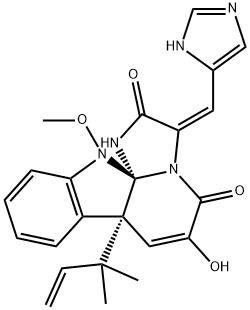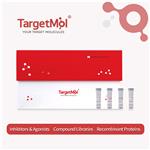
MELEAGRIN
- Product NameMELEAGRIN
- CAS71751-77-4
- CBNumberCB7816480
- MFC23H23N5O4
- MW433.46
- EINECS604-604-1
- MDL NumberMFCD08702703
- MOL File71751-77-4.mol
- MSDS FileSDS
Chemical Properties
| Melting point | >165oC |
| storage temp. | -20°C |
| solubility | Soluble in DMSO (up to 10 mg/ml) |
| form | Yellow oil. |
| color | Tan |
| Stability | Stable for 1 year from date of purchase as supplied. Solutions in DMSO may be stored at -20°C for up to 3 months. |
| FDA UNII | 5780K492K3 |
MELEAGRIN Price
| Product number | Packaging | Price | Product description | Buy |
|---|---|---|---|---|
| Cayman Chemical 17850 | 1mg | $153 | Meleagrin ≥98% |
Buy |
| Cayman Chemical 17850 | 5mg | $571 | Meleagrin ≥98% |
Buy |
| TRC M215335 | 1mg | $135 | Meleagrin |
Buy |
| TRC M215335 | 10mg | $960 | Meleagrin |
Buy |
| Biorbyt Ltd orb545931 | 1mg | $289 | Meleagrin >98% |
Buy |
MELEAGRIN Chemical Properties,Usage,Production
Description
Meleagrin (71751-77-4) is a novel alkaloid biosynthesized via the roquefortine branched biosynthetic pathway.1,2? Displays excellent ATP-competitive c-MET inhibition, inhibiting the growth, migration and invasion of numerous breast cancer cell lines.3 Also has been shown to inhibit the bacterial enoyl-acyl carrier protein reductase (Fabl) with IC50s in the 33-40 mM range.4Uses
Meleagrin is a is an antibiotic derived from the deep ocean and is identified as an inhibitor of the bacterial enoyl-acyl carrier protein reductase. (Fabl). Inhibits the growth of S. aureus, E.coli, and S.pneumoniaeUses
Meleagrin is an alkaloid with antitumor and antibiotic activity, isolated from a number of species of Penicillium. Meleagrin is a common taxonomic marker for fungal contamination of foodstuffs. Despite its wide detection in the environment, the mode of action and bioprofile has not been extensively reported. Note that meleagrin, the fungal metabolite, should not be confused with the low molecular weight protein, also meleagrin.Definition
ChEBI: An indole alkaloid with a heterotetracyclic skeleton isolated from Penicillium oxalicum.in vitro
it was found that consistent with their selective inhibition of staphylococcus aureus fabi, meleagrin and its more active derivatives could directly bind to s. aureus fabi that was measured in a fluorescence quenching assay, inhibit intracellular fatty acid biosynthesis and growth of s. aureus, and increase the minimum inhibitory concentration (mic) for fabi-overexpressing s. aureus. the compounds that were not effective against the fabk isoform, however, were able to inhibit the growth of streptococcus pneumoniae containing only the fabk isoform. in addition, no resistant mutant to these compounds was obtained. notely, fabk-overexpressing escherichia coli was found to be not resistant to these compounds, but was resistant to triclosan [1]. another study found that meleagrin was able to inhibit the growth of the human breast cancer cell lines, while similar treatment doses had no effect on the growth and viability of the non-tumorigenic human mammary epithelial cells mcf10a. meleagrin also displayed good atp competitive c-met inhibitory activity in z-lyte assay [2].storage
+4°CReferences
1) Ries et al. (2013), Novel key metabolites reveal further branching of the roquefortine/meleagrin biosynthetic pathway; J. Biol. Chem., 288 37289 2) Newmister et al. (2016), OxaD: A Versatile Indolic Nitrone Synthase from the Marine-Derived Fungus Penicillium oxalicum F30l; J. Am. Chem. Soc., 138 11176 3) Mady et al. (2016), The indole alkaloid meleagrin, from the olive tree endophytic fungus Penicillium chrysogenum, as a novel lead for the control of c-Met-dependent breast cancer proliferation, migrations and invasion; Bioorg. Med. Chem., 24 113 4) Zheng et al. (2013), Meleagrin, a new Fabl inhibitor from Penicillium chryosogenum with at least one additional mode of action; PLoS One, 8(11) e78922Preparation Products And Raw materials
MELEAGRIN Supplier
Global(65)Suppliers
| Supplier | Tel | Country | ProdList | Advantage | |
|---|---|---|---|---|---|
| +undefined-21-51877795 | ivan@atkchemical.com | China | 33025 | 60 | |
| +1-781-999-5354 +1-00000000000 |
marketing@targetmol.com | United States | 32159 | 58 | |
| +86-0371-86658258 +8613203830695 |
laboratory@coreychem.com | China | 30231 | 58 | |
| tp@aladdinsci.com | United States | 52924 | 58 | ||
| +86-86-57188162785 13606544505 |
lucy@verychem.com | China | 1081 | 58 | |
| 1-631-485-4226; 16314854226 |
info@bocsci.com | United States | 14055 | 65 | |
| 021-52996696,15000506266 15000506266 |
China | 4587 | 55 | ||
| 021-65675885 18964387627 |
info@efebio.com | China | 9804 | 58 | |
| 86-(0)29-85992781 17792393971 |
info@lynnchem.com | China | 4587 | 58 | |
| 44-20819178-90 02081917890 |
info@novachemistry.com | United Kingdom | 4381 | 58 |
View Lastest Price from MELEAGRIN manufacturers
71751-77-4, MELEAGRINRelated Search
PROMPT×
PROMPT
The What'sApp is temporarily not supported in mainland China
The What'sApp is temporarily not supported in mainland China
Cancel
Determine
